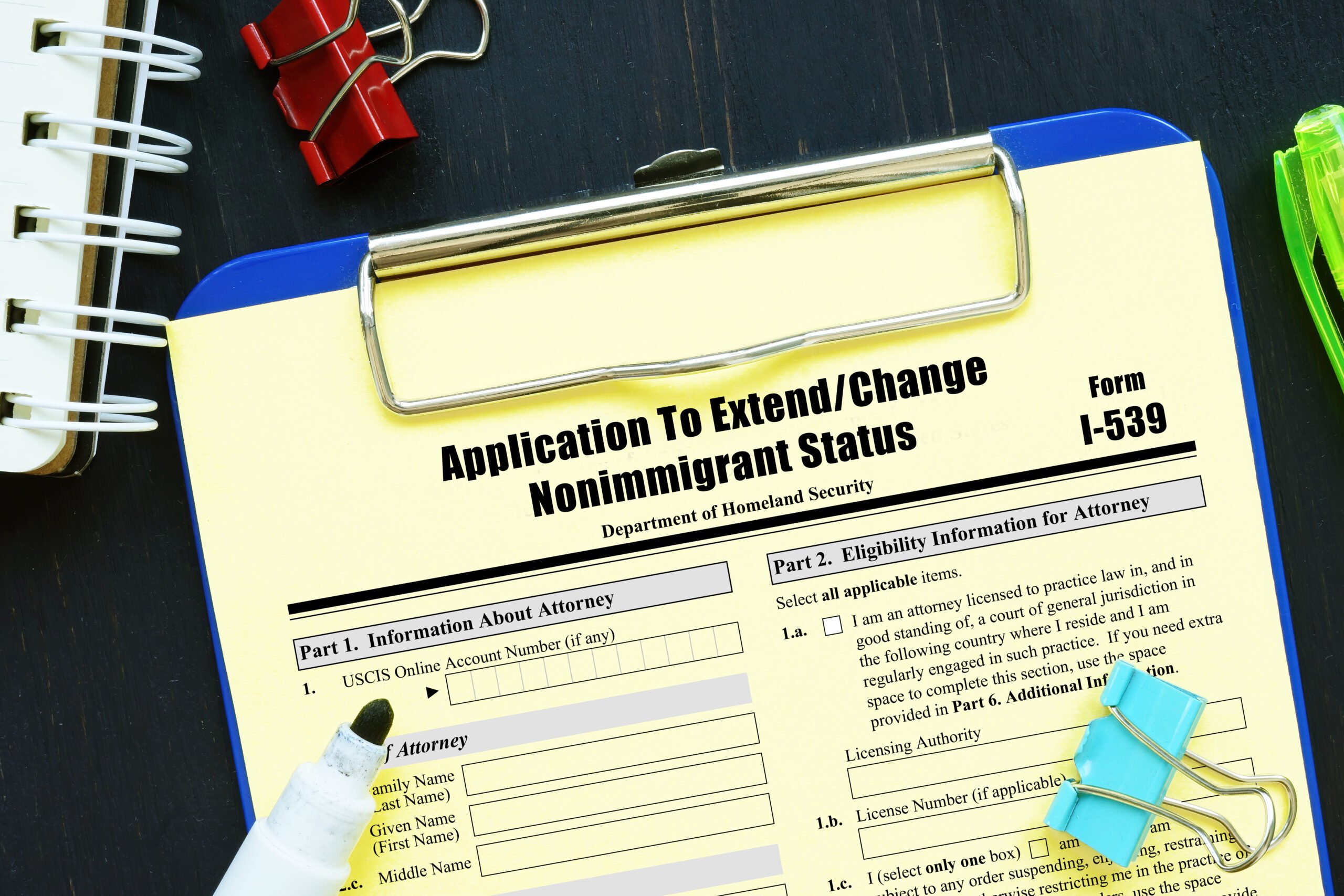Generally, certain nonimmigrants present in the United States admitted for a specified period of time, or their petitioners may request an extension of their admission period in order to continue to engage in those activities permitted under the nonimmigrant classification in which they were admitted.
Also, certain nonimmigrants present in the United States, or their petitioners may seek to change their status (COS) to another nonimmigrant classification if certain requirements are met. If you want to change the purpose of your visit while in the United States, you (or in some cases your employer) must file a request with USCIS on the appropriate form before your authorized stay expires. For instance, if you arrived in the US as a tourist but want to become a student, you must submit an application to change your status.
What is Form I-539?
Form I-539 (Application to Extend/Change Nonimmigrant Status) is one of the forms issued by the USCIS. It is used by people currently in the United States in a non-immigrant status to change the classification for their status and/or extend their stay with their current status. Both the current status and the status to which the transition is being sought must be non-immigrant visa statuses.
Applying for an extension of stay
If you want to extend your stay in the United States, you must file a request with U.S. Citizenship and Immigration Services (USCIS) on Form I-539 before your authorized stay expires.
It is recommended that you apply to extend your stay (EOS) at least 45 days before your authorized stay expires (however, we recommend that you apply as soon as you determine that you need to change to a different nonimmigrant category or extend your stay).
You may apply to extend your stay if:
- You were lawfully admitted into the United States with a nonimmigrant visa,
- Your nonimmigrant visa status remains valid,
- You have not committed any crimes that make you ineligible for a visa,
- You have not violated the conditions of your admission,
- Your passport is valid and will remain valid for the duration of your stay.
Additionally to the Form I-539 in most cases you will need to attach:
- a copy of your I-94 (including separate I-94s for everyone included in your Form I-539.)
- full English translations of every document submitted in another language
- the appropriate fee ($370 for most applicants in 2022, with most applicants also required to pay the $85 biometrics fee)
- for dependents (spouses or children), birth or marriage certificates proving the relationship to the main visa holder or applicant
- documents showing your need for the extension of change in status,
Filing fee for I-539 form is $370, accompanied by $85 biometrics fee.
The processing time of I-539 is nowadays long. It usually takes around 6-9 months to review the applications or sometimes even longer depending on the workload of USCIS service centers (with the Covid-19 pandemic the processing time may lengthen).
You can legally stay in the US while your I-539 is pending, even if your status is expired, so you can keep your I-539 receipt while traveling in case you run into an interior immigration checkpoint.
Which Visa’s statuses are not renewable?
There are certain U.S. travelers who are not eligible to apply for extension and / or change of status. These individuals are required to leave the United States prior to the expiration date noted on the I-94, which is the maximum length of stay allowed.
This affects the following individuals:
- Individuals who have violated the conditions of their visa or committed criminal offenses,
- Holders of the following nonimmigrant visas:
- C (Alien in Transit),
- K-1 or K-2 (Fiancée or Dependent of Fiancée),
- S (Witness or informant beyond a total of 3 years),
- TWOV (Transit Without Visa)
Travelers who are staying in the United States under the Visa Waiver Program with ESTA. This means that ESTA holders must leave the United States after a maximum of 90 days. However, due to the Covid-19 pandemic, Visa Waiver travelers who are unable to leave the country in time (canceled return flight, stationary hospital stay, etc.) and who are therefore threatened with exceeding their issued maximum stay of 90 days, can apply for a satisfactory departure status and extend their stay in the U.S. for up to 30 days at a time under a goodwill arrangement by the U.S. Customs and Border Protection (CBP).
Conclusion
Anyone who has ever encountered the USCIS knows that there is no place for mistakes. Whether you apply for an extension of your visa or change of your current status in the United States, at PassRight, our team can help you through the process and ensure everything is filed correctly. We provide the reliable counsel and compassionate guidance you need to reach this goal.
If you have any questions about your eligibility, or how to fill out the form and prepare the application contact us at info@passright.com.
FAQs
What is a Non-immigrant Visa?
Nonimmigrant visas are issued by the U.S. Department of State to foreign nationals who intend to remain in the United States for a temporary period. The period varies for different nonimmigrant classifications.What is Form I-94?
Form I-94 is the DHS Arrival/Departure Record issued to aliens who are admitted to the U.S., who are adjusting status while in the U.S. or extending their stay, among other things. A U.S. Customs and Border Protection (CBP) officer generally attaches the I-94 to the non-immigrant visa- tor’s passport upon U.S. entry. The visitor must exit the U.S. on or before the departure date stamped on the I-94.What are the consequences of exceeding the validity of your visa?
If you remain in the United States longer than authorized, you may be barred from returning, and/or you may be removed (deported) from the United States. Check the date in the lower right-hand corner of your Form I-94, Arrival-Departure Record, to determine the date your authorized stay expires.









